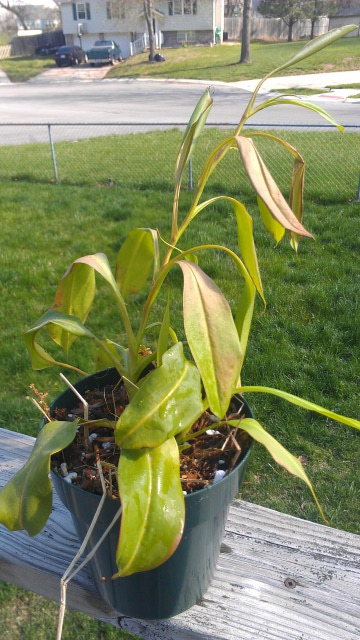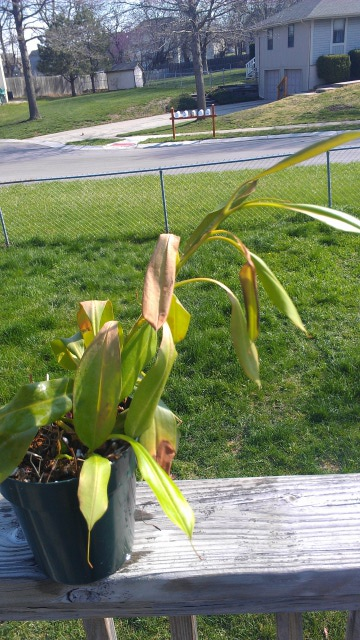Question
 nepenthes 1
nepenthes 1  nepenthes 2
nepenthes 2
Hi all.
In early October 2013, I bought a Nepenthes alata x truncate from growvarnivorousplants.com. It arrived and it was doing beautifully. I live in Kansas City, where it gets very cold in winter and absurdly hot and humid in the summer, so shortly after I bought it I brought the plant inside and I continued to grow it under a grow light, regularly watering it and leaving the light on it for 10-12 hours daily. It's grown incredibly since the time I purchased it, and even had new growth growing from the bottom of the plant. The light burned out, and I didn't replace it, figuring the cold weather was over so I could put it outside. I decided to try repotting it. I bought the nepenthes soil (http://www.growcarnivorousplants.com/Tropical-Pitcher-Plant-Soil-p/09022.htm) from the same website I purchased the plant from, along with a six inch pot. I repotted, and watered thoroughly as the soil was quite dry when I got it. I put the plant outside as we were getting nice weather and it seemed to be doing great. Of course we got a few cool nights and I brought the plant inside, so it was without light for 2 days while it surprisingly snowed. I went to check on the plant today, and some of the upper/middle leaves are quite brown in color, while the new growth down below still looks vibrant and green. Some of the leaves are brown on the inside but still green in the center.
Unsure of what to do exactly, I went and got a new grow light, watered the plant (soil was a bit dry), and put it under the light hoping it can recover.
Does anyone have any tips or advice on where I went wrong here? was it the repotting, or can one of these plants really make that type of turn in 2 days time? Any advice would be great. This is my oldest and biggest plant and I don't wanna lose it!!!
AnswerTwo things come to mind based on your description and photos. The first is sunburn. Your plant is showing the classic signs of sudden exposure to very bright sunlight. Whenever placing your plants outside after it was growing indoors or under lights, you will need to acclimate it to UV light. Think of needing to build a base tan before spending any significant time in the sun. The leaf damage is permanent, so those leaves will remain that way until they die off.
The second issue is cold exposure. Based on your description ("Of course we got a few cool nights and I brought the plant inside..."), I'm not sure if you brought your plant inside before the nights got cool or you left your plant outdoors during the nights when it was cool, but before it snowed. I also don't know what you mean by cool nights. (How low did the temperature get?) Regardless, your plant is also showing signs of cold damage from the very limp leaves. In cold temperatures, water flow to the leaves are interrupted, which causes wilting. Sun damage can cause this too, but we can't rule out cold damage since you had your plant outdoors for the night. While this particular hybrid is tolerant of cool nights, you need to acclimate it properly. Furthermore, cool nights is generally defined as the mid to upper 50s. Nights in the 40s is generally too cool for most Nepenthes without suffering leaf damage.
While outdoors, the soil will also dry much quicker, so you have to be very vigilant about watering. You mentioned that the soil was slightly dry when you moved it back indoors. If the soil is dry during cold nights, the roots will be less insulated against the rapid temperature swing, which can damage them.
Overall, it's an acclimation issue. Your plant was happily growing well in a warm, cozy, bright location before you moved it outdoors where the sun was stronger and the nights were much cooler. The transition was too sudden. It should have happened gradually.
As long as the plant wasn't exposed to really cold temperatures and the roots weren't damaged from the cold, the plant should survive, though you will have to accept the leaf imperfections. When your plant produces basal shoots, you can likely cut off the longer vine. After that, your plant will look like nothing happened, but this may be 6 months down the road.
So move your plant back under the grow lights, keep the soil moist at all times, and cross your fingers. Only time will tell how much damage had occurred. There's nothing more you can do right now. Even if this plant were in our care, all we could do is wait.
If you subscribe to our monthly newsletter, you will get information about when it's safe to move your tropical plants outdoors. For most of the country, it's early June. We notify growers when to do this and how to properly acclimate their plants.
Good growing!
Jacob Farin







